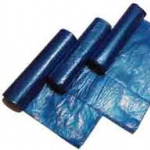| Nano baspar aytak Ltd |

| Registration Date | 18 Feb 2016 |
| Revision Date | 21 Apr 2018 |
| Share |
Food Packaging
Garbage BagSilver
Ag Nanoparticle /Nanopowder CAS Number : 7440-22-4This product is an antibacterial trash bag containing silver nanoparticles with less than 20 nm in size. Silver concentration is 18 ppm in it. Silver nanoparticles attach to the surface of the cell membrane and disturb such properties as permeability and respiration. It is reasonable to assume that the binding of the particles to the microorganisms depends on the surface area available for interaction. Smaller particles having the larger surface area available for the interaction will give a greater bactericidal effect than larger particles.
Polyethylene (PE) is the most commonly used plastic polymer in the world. In general, porous PE is considered a strong, lightweight thermoplastic with strong chemical resistance. Extensive research has been carried out in the last decades in order to investigate possible methods to prepare antibacterial plastics. New plastic materials with inherent antibacterial properties can be made for this purpose by polymerization or copolymerization of new monomers or by chemical modification and/or blending of polymers. The most frequently used approach to prepare antibacterial plastics is to include various organic or inorganic substances, such as tea extract, chitosan, copper, silver, zinc, etc. in polymer matrices. Among the additives used to improve the antibacterial activity of plastics, those able to release silver ions have long been known to have strong bactericidal effects as well as a broad spectrum of antimicrobial activities. It is generally believed that heavy metals react with proteins by combining the thiol (– SH) groups, which leads to the inactivation of the proteins. The interaction of silver ions with thiol groups plays an essential role in bacterial inactivation.